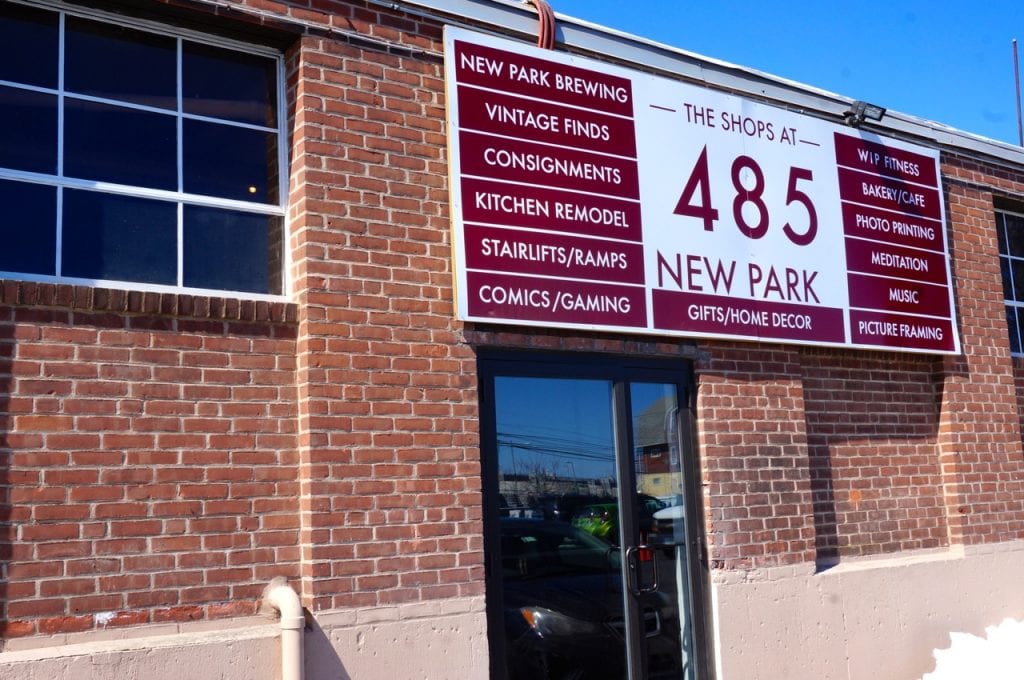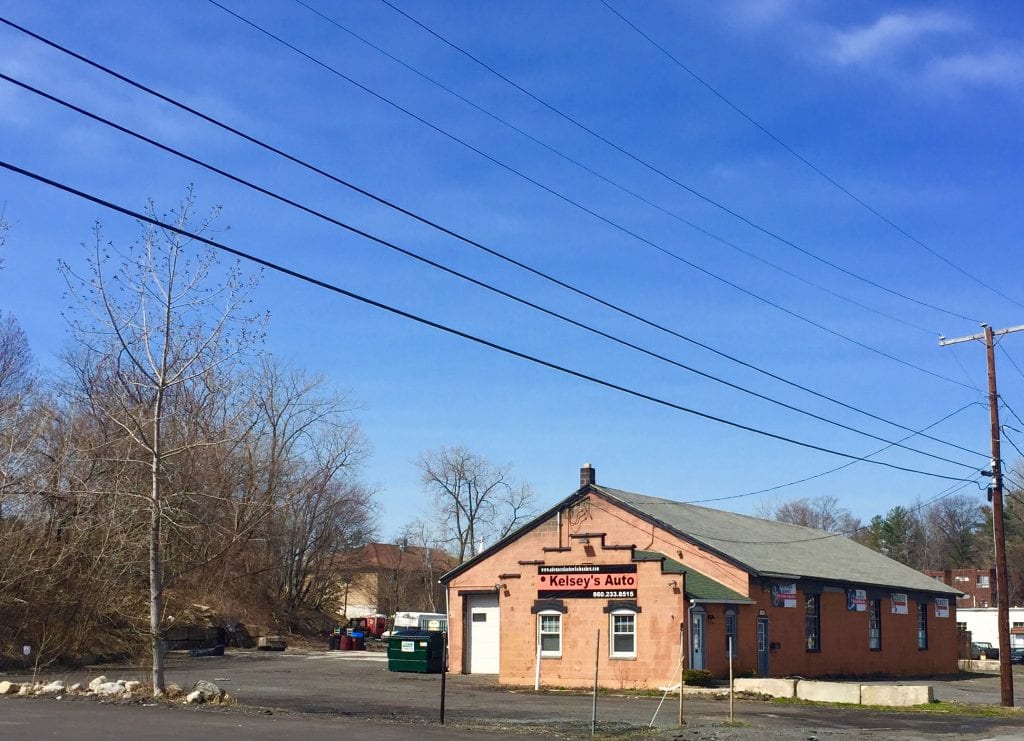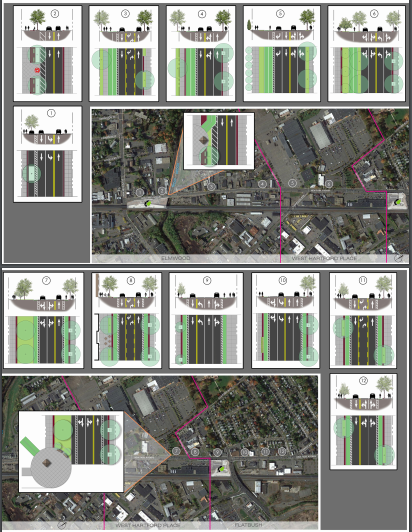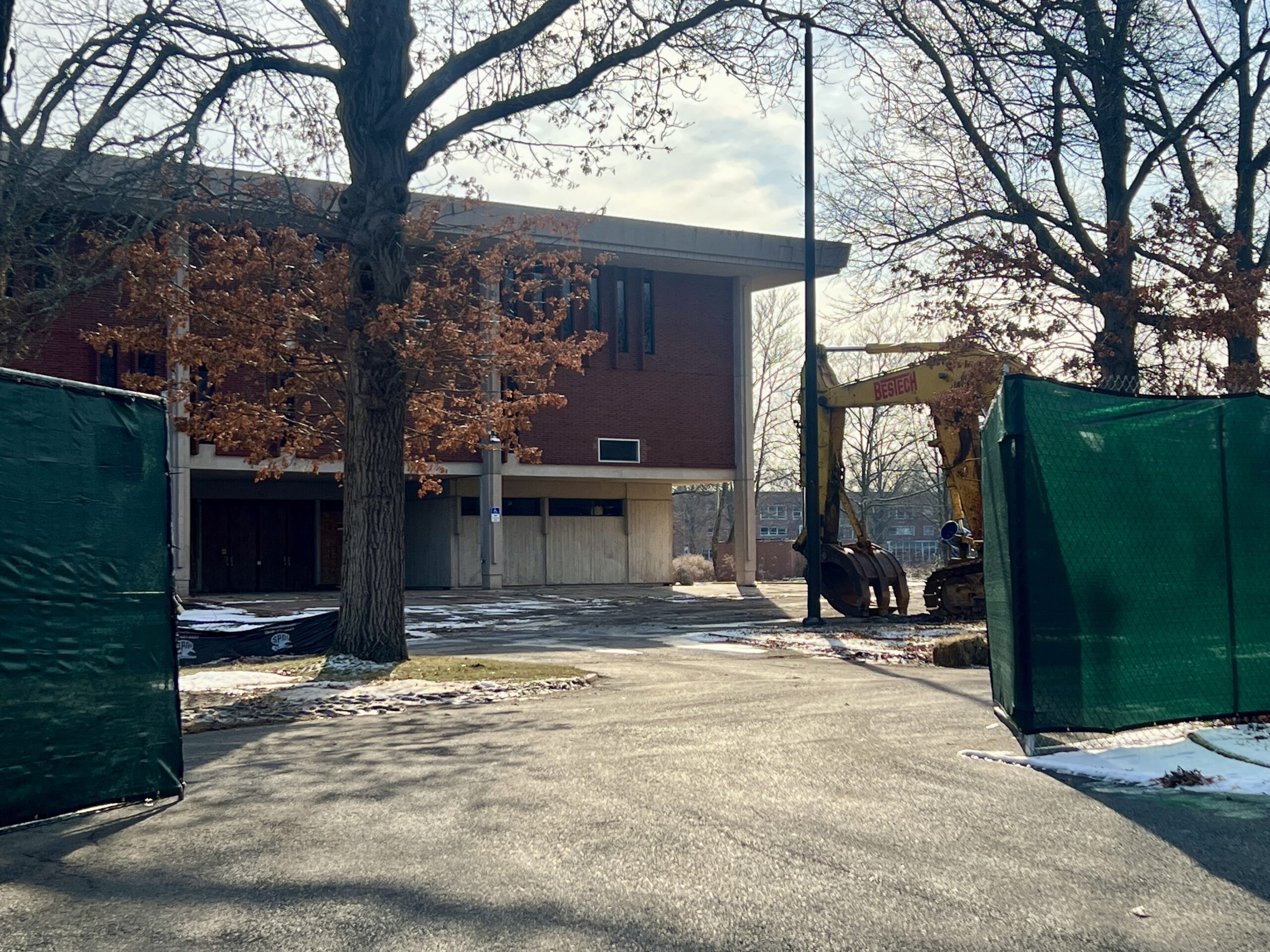New Park Avenue Corridor Poised for Transformation

Audio By Carbonatix

A 'foundation-setting' was held for the 616 New Park mixed-use development on the same date as CTfastrak's second anniversary – all signs of development in the New Park Avenue corridor of West Hartford. Photo credit: Ronni Newton
The next generation of West Hartford’s industrial area is a new vibrancy fueled by zoning changes to allow mixed-uses, breweries, and now food trucks.
By Abigail Albair, West Hartford Press Editor
It may be in an industrial zone, but New Park Avenue will soon boast a bit less of an industrial style, and take on more of the eclectic flair that has been burgeoning in that area of town as transit opportunities and zoning changes allow for growth.
In the last month, local and state officials gathered to celebrate the “foundation setting” on 616 New Park Avenue, a new mixed-use, transit oriented development, and the Town Council approved a zoning change to allow food trucks in the area.
The well-traveled strip, bookended by The Corner Pug and Raymour & Flanigan, has long been known for being the harbor of the Home Design District – an association of businesses located in the one square mile section of town that all offer products and services to homeowners looking to renovate, decorate, repair, furnish or create a home.
That group has had continued success, even hosting collaborative events to draw in hundreds of customers and celebrate the community.
Within the last 10 years, artistic vibes started to radiate from the 100-year-old industrial building between Jefferson Avenue and Darcy Street that was once a ball bearing factory.

New Park Brewing is the newest business to open at 485 New Park Ave. in West Hartford. Photo credit: Ronni Newton
The Shops at 485 New Park is now filled with a variety of businesses, many artsy in nature, such as Blaze & Bloom, Panache Consignment, Hello Dahle and others.
In March, the building celebrated the grand opening of a new and wildly popular business, New Park Brewing.
“It took us three years to open,” founder and co-owner John H. Doyle said opening day, March 25. “During that time, we met a lot of people who loved our beer. We’re totally blown away by the response.”
Doyle and co-owners Tom Atkins and head brewer Alex Dee are all West Hartford residents.
A zoning change in September of 2015 allowed manufacturers of alcohol to set up shop in industrial zones, where previously such facilities were not allowed in any zone. At the time, the town had received multiple inquiries from microbreweries.
New Park Brewing brought to fruition the concept that the town wanted to allow in the New Park Avenue area as a way to add to the section’s vibrancy.
A previous zoning change in 2014 permitted residential uses in the general business zone and general industrial zone to allow mixed-use development on New Park, and now, another zoning change made at the end of March, will allow food trucks and food truck parks in the industrial zone.
“I think New Park Avenue has been going through a regeneration over several years now,” Director of Community Services Mark McGovern said. “A lot of good things are happening there and it’s really sort of picking up steam. We’re doing what we can to capitalize on that and spur move investment in that area.”
Recent investments, such as Cumberland Farms that redeveloped a blighted property or the opening of the popular franchise Chick-fil-A, have made a big impact, McGovern said.
“I think we’re poised for even greater investment,” he said.
All the zoning changes have been to address an existing demand, he said.
“With the introduction of transit, there became a demand for housing, but we needed to tweak zoning to permit that. Brewing has become a really popular endeavor, and it’s perfectly located on New Britain Avenue, but we needed to tweak the zoning to allow that. Food trucks is the trend but it didn’t fit nicely with our regulations,” he said. “We were careful in how we did all these things to make sure it would fit in. I think that sort of comes with an area that is changing and [New Park Avenue], traditionally, has been a center for manufacturing. Though we still have a number of industrial uses there, which is very important, there is more there now.”
He noted that Colt Manufacturing, which came out of bankruptcy last year, has announced it will buy its headquarters on New Park and expand.
That is a positive thing for the area and town to have such a major employer based there, he said.
The increasing variety of businesses, combined with the brewery and now food truck availability, is solidifying the area as a destination for those both from inside and outside of town.
“We have these new modes of transportation that can bring people, workers, customers, residents to arrive other than by car,” he noted. “What I would certainly like to see is New Park Avenue to be much more like some of our other districts where we see people walking from location to location. Then it becomes more of a neighborhood than an industrial commercial district.”
Foodie destination

Gastro Park will be proposed for 637 New Park Ave. in West Hartford, and the existing garage building will serve as a commissary, storage for food truck vehicles, and will have an addition that will include restrooms and a bar. Photo credit: Ronni Newton
The discussion was prompted by an increase in local interest in locating trucks in town. Prior to the ordinance approval, the town had only the “classic ice cream truck ordinance,” Corporation Counsel Pat Alair said, which allows trucks to stop only to serve patrons for a maximum of 10 minutes.
If Gastro Park – the food truck park that is the brainchild and dream of Iron & Grain co-owners Tate Norden and Adam Belward – comes to fruition, it will further enhance West Hartford’s reputation as a foodie destination, and bring an additional vibrancy to the New Park Avenue corridor. Plans will be submitted in the coming weeks.
The New Park Avenue corridor was the area of town he had in mind for the park all along, he said.
“That was our desire and destination from the get-go,” he said. “I was aware of the growth going on. I knew there was a brewery hoping to go there and was aware of 616 New Park. I saw an opportunity for this portion of town that, for many years, was basically just an industrial area.”
Backed by a group of investors, Norden and his partners are hopeful they can have Gastro Park up and running by September and draw more people to the corridor.
“We saw this as an opportunity that this is now going to become a much more exciting, vibrant and artistic unique sort of space that will make West Hartford that much more exciting to live in and visit,” he said.
Norden is in the process of purchasing a just shy of one-acre site at 637 New Park with the closing slated for the end of May.
“Iron & Grain is, for all intents and purposes, the first customer,” he said.
“The interest among trucks and consumers has really been astounding,” Norden said of the park. “More and more food trucks are coming into the Connecticut scene every year, run by amazing chefs doing really
cool and often times locally-focused cuisine.”
His broader goal for West Hartford is that Gastro Park will turn New Park Avenue into a “great hotbed for local small business and development in town.”
“That’s really what we want the food truck park to be. We want it to be a small business ecosystem,” he said. “Aspiring restaurateurs can use the Gastro Park to help grow their own business, whether proving out a concept or building their own food truck business. I would love to see that happen throughout all of New Park. It’s such a neat little spot with cool businesses already existing there. I think this can be the start of something greater for the area.”
He noted the many businesses now succeeding in the area, including a variety of fitness businesses, UberDog and Hartford Baking Company. He’s looking forward to seeing what retail comes to the ground floor of 616 New Park.
In his own business, he will continue a focus on local sourcing.
“We launched Iron & Grain thinking we could support farms, distilleries and other groups making local products because a community is only as strong as the local businesses that make it up,” he said. “I think [Gastro Park] can be a very big draw, and draw on a whole other segment of people to town and to this area.”
When the food truck ordinance was approved, Deputy Mayor Leon Davidoff said he was impressed by Norden and the “spirit of the food truck industry,” marked by small entrepreneurs searching for the American Dream.
“Over the years our town has progressed, maybe slowly but we have progressed. We used to be a community where outdoor dining was looked down upon. Now I can’t think of any restaurant that would want to locate in West Hartford that didn’t have the option of dining outdoors,” Davidoff said. “We’re really building on what kind of environment, what kind of atmosphere, what kind of community do we want to create for millennials? That’s our next generation.”
Transit-oriented development

Alternatives that may be considered to make New Park Avenue more pedestrian friendly. Town of West Hartford image
After years of effort, the West Hartford Housing Authority and Trout Brook Realty Advisors marked the foundation setting of 616 New Park. The $20 million, mixed-use building will be just north of the Elmwood CTfastrak station.
The new development will include both market-rate and workforce housing units, along with 11 units of supportive housing specifically for veterans. The first floor of the building is reserved for commercial use, with a tenant yet to be determined.
The property is meant to attract young, working professionals who want an urban lifestyle with quick access to transportation in a vibrant, walkable neighborhood, representatives said, and many praised the fact that the project is indicative of the success of CTfastrak as a way to diversify transportation options in the New Park corridor and make it attractive to development.
“With CTfastrak, you could have or not have a car and get into the downtown of both cities. To me, it feels like Brooklyn, with its sense of urban sustainability. It’s a place to walk,” George Howell, the West Hartford Housing Authority president, said when plans for the project were unveiled.
The town has worked for many years to facilitate smart growth via TOD and mixed-use development and to harness opportunities created by CTfastrak and the CTrail Hartford Line.
Design and environmental permitting for the rail line stations in North Haven, Newington, Windsor, Windsor Locks, and Enfield, along with the Flatbush Avenue Station in West Hartford, is now moving forward as the state bond commission approved an additional $50 million in funding for the project earlier this year.
The CTrail Hartford Line is set to launch next year and increase the number of round-trip trains from six daily Amtrak intercity and regional trains to 17 round-trip trains a day to Hartford and 12 trains per day to Springfield, though West Hartford will not be a stop on the line until the local station is built, which is further off.
The town just recently concluded a yearlong study of New Park Avenue that was funded by a state Office of Policy Management grant.
“The emphasis of our study was the New Park Avenue corridor and ways in which we could improve it with a focus on complete streets and connectivity into, out of and through the [transit] stations,” explained Town Planner Todd Dumais.
The challenge for the area, according to the final report of the study, is the “juxtaposition of the auto-centric corridor with industrial and suburban style retail uses, four lanes of vehicular traffic, no bicycle accommodations, and narrow sidewalks with the expected influx of pedestrians and bicyclists.”
The preferred alternative resulting from the study is an approach to New Park Avenue that would essentially be a “road diet,” or reduction in travel lanes, to make way for bike lanes, planted medians, new sidewalks and other streetscape enhancements.
Continued changes in zoning to support transit-oriented development are also encouraged, though Dumais said the actual changes will depend upon how involved the town wants to be in terms of making adjustments. Steps could include creating an overlay zone around each transit node, making changes to the underlying zone or creating a new zone to impact the entire corridor.
The report resulting from the study recommends making changes in the areas around each CTfastrak station.
“The zoning recommendations are not heavy,” Dumais said. “They’re saying we need to preserve industrial uses and the Home Design District while creating new streetscape and landscape requirements that beautify the frontage of properties, screen parking and create smaller neighborhoods around the transit stations.”
Dumais said the longterm vision for New Park Avenue is that it continues to become a more attractive, pedestrian-friendly environment with more mixed use development.
The town intends to continue to update zoning regulations and undertake complete streets improvements to facilitate creative development in the corridor.
“I think 616 New Park is kind of the pioneer for that potential vision,” he said.
He hopes West Hartford can secure grant funding to make changes to the physical infrastructure of the street.
“That would be a dramatic improvement to reintroduce an aesthetic appeal and slowly start to see incremental change,” he said.
Like what you see here? Click here to subscribe to We-Ha’s newsletter so you’ll always be in the know about what’s happening in West Hartford!



